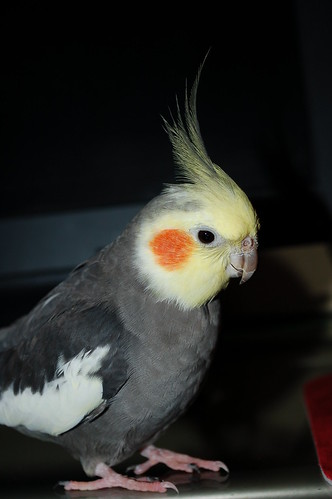
Cockatiel
My cockatiels, Tinky and DeeDee, have been joined at the hip forever. Except for a brief period of introduction (the importance of quarantine was not emphasized back when I first started my flock), they have done everything together from the beginning, including sharing a cage.
For some time, they were housed with cockatiels Henry and Cocoa, who have since passed, and they lived in perfect harmony as cockatiels so often do. They were great together.
As I mentioned in a recent post, the two were not doing particularly well. Tinky had started sneezing. At first, the sneezes were dry and infrequent. As I always do, I looked at the problem from a dietary standpoint first.

cockatiel
I know that sneezing is often the result of a vitamin A deficiency. The lack of vitamin A will cause skin tissue, including the nasal membranes, to dry out. The body compensates by over producing mucus in that area and eventually infection occurs.
I always include foods high in beta carotenes (which are converted to vitamin A in the body) in every morning meal for all of the birds. When Tinky began sneezing, I upped the amount that the tiels got everyday, but it wasn’t making a difference.
My cockatiels are not my best eaters. They had started their life on an all seed diet as instructed and until I realized on my own (read this post) that this was not the right diet for a bird, they survived on that. In fact, I can only call their current dietary habits satisfactory, meaning they eat just enough of their veggies to keep me from constantly worrying about their health. They have always eaten enough good things to stay healthy over the years.

cockatiel
Right around the same time, I notice that DeeDee wasn’t looking “right”. His posture was slouchy and pitched forward. I have always recognized that as a sign of illness in a parrot and off the two went to the vet.
Tinky received a nasal flush and was prescribed an antibiotic. It was a couple of days before I got word back on DeeDee’s blood work. When the doctor told me that DeeDee was suffering from malnutrition, the first word out of my mouth was: “Impossible!” Just as I was about to launch into a detailed defense of the diet I feed my birds, I realized what he was saying. I quietly said: “Oh, no.”
We both knew the birds were on a great diet. This meant one of two things: either DeeDee wasn’t eating or, worse, his body was unable to process nutirents from the foods he was eating. The vet went on to explain that the liver and kidney enzymes did not indicate problems and he suggested that Tinky might be preventing DeeDee from eating.
Even though this was the better of the two possibilities, I couldn’t, and still can’t, understand why this might be the case after so many years of co-habitation. I knew this meant I had to separate the two and dreaded doing so.

Cockatiels, Tinky and DeeDee
Tinky has always been the largest of my cockatiels. As such, he has claimed himself to be king and the other cockatiels have always deferred to his status. If something in the house is amiss, they always look to his guidance and will remain calm so long as he does. He is, of course, the first to check out any new toys and gets the prime spot on my shoulder that his title allows. I have always regarded him as a strong leader, but never saw him as a bully. I had a hard time accepting he vet’s presumption that he was the problem.
Still, there was no other plausible explanation, so currently, the birds are caged separately during the day, but enjoy out of cage time together. At night, since there is no eating going on anyway, I put the two to bed together in one cage. Since the two have been segregated, I have noticed two important things: 1) DeeDee will only eat after Tinky is done with his meal, even while in a separate cage, and 2) whenever DeeDee excuses himself from playtime and heads to the cage for a bite to eat, Tinky follows and DeeDee leaves. It looks like the vet is right.

Cockatiel and rosebreasted cockatoos
Even though many birds enjoy and find comfort in having another of its species nearby, it can lead problems in their care. The situation with Tinky and DeeDee is just one example of how things can go wrong when more than one bird is kept in a cage.
It is also difficult to determine the poor eating habits of any particular bird when all birds have access to all food dishes. There is to know way to know, with certainty,that each is eating what they should.
Most diseases that birds acquire are spread through feces. When birds are housed together, disease is quickly spread to the entire flock. Further, since the quality of the droppings is how we monitor each bird’s health, there is no way to know which poop belongs to which bird.
I am not suggesting that you keep your flock apart if they enjoy each other’s company – that could be stressful to a bird that has grown comfortable with sharing a cage. Birds are a species that find strength in unity. However, it is more important to observe these birds individually and to take action if one seems ill or is being opressed by the others.
Just because birds are not actively fighting doesn’t mean that all is well, as I recently discovered.
Author Patty Jourgensen specializes in avian health, behavior and nutrition and has been working with and caring for rescue birds since 1987.



Be the first to comment